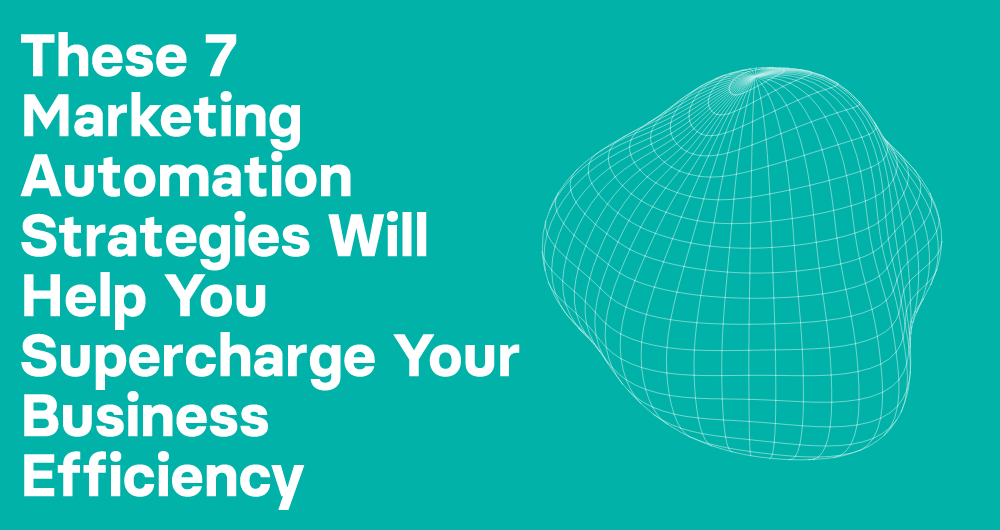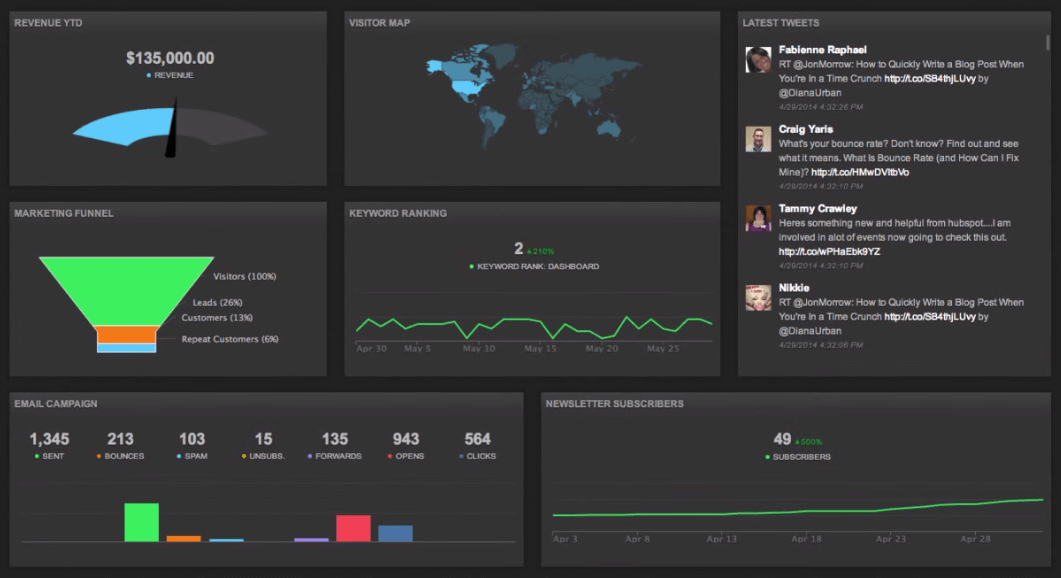These 7 Marketing Automation Strategies Will Help You Supercharge Your Business Efficiency
Marketing Automation Insider is supported by readers like yourself. We may earn an affiliate commission when you purchase through our links. Of course, this won't increase the cost of your subscription.

If there’s one area in a business that always has room for growth, it’s efficiency. Making the absolute most of your resources – your time, your leads, your employees’ work, your content, etc. – is a constant struggle that will never truly be totally conquered.
What you can do, however, is come ever closer to that 100% resource maximization mark.
Here are 7 practical strategies, made possible by automation, that you can start using today to supercharge your business into becoming a well-oiled, efficient machine. We’ll go over things that can help you save time, get more work done, and make the most of your website traffic and leads.
Let’s get started with strategy #1.
1. Plan & Write Your Content in Advance
Image credit: photosteve101 via Flickr
When you’re in the middle of a stressful time in your business — say, for instance, when you’re releasing a major product update or when you’re just putting the finishing touches on your biggest ever client project — creating content for your marketing is probably the last thing on your mind.
Before, you were simply plodding along with your content campaign without a strict schedule in mind. All of a sudden, you have no content being published because you have no time to produce it. This will end up negatively affecting the flow of your content marketing and will cause you to lose traction with readers.
The solution?
Plan ahead.
Write your content in advance, then set it for publication at a specific date and time. That way, you’re well-prepared in the event of emergency and the flow is never disrupted.
You can even use automation to set certain parts of your promotional strategy to happen in advance. For instance, you can pre-publish social shares for the post (more on that below) or even write emails promoting your posts (this should be a part of your outreach strategy) in advance, scheduling them to be sent at a specific time after your content gets published.
2. Automate Social Media
Social media is definitely one of the biggest time sucks in modern-day marketing. One minute, you’re tweeting an update, and then an hour later you’re still on Twitter checking out the latest trends.
It’s crucial for your productivity that you minimize both the amount of time you spend during each session of social media marketing, and the number of such sessions you have.
Strict schedules will accomplish the first goal, and automation can help with the second.
Write a couple weeks’ worth of social media updates all in one sitting, then use a tool like Buffer or Hootsuite to schedule each post accordingly (use this guide to determine the best days and times to post on social media for maximum engagement).
3. Segment Email Lists
Recent research from Mailchimp has shown that segmented email lists perform significantly better than non-segmented ones. Open rates were on average 14.22% higher, unsubscriptions 7.69% lower, and click-throughs were a staggering 55.38% more frequent!
Clearly, if you haven’t already started segmenting email, you’re missing out big-time (click to tweet).
There’s an endless number of tags you can use to classify your email list into sublists. A few obvious ones are interests, geographic location, purchase frequency, and how the lead prefers to consume content (content format).
Once you’ve setup a segmentation system with your marketing automation tool, you can start sending personalized emails to each group of leads using the information you got when categorizing them.
Although in the short run personalizing email campaigns is just a lot more work, the increased engagement is definitely worth it in the long run, especially after you’ve cultivated a sizeable list.
4. Gather Analytics to One Dashboard
When measuring your website performance, your analytics are no doubt strewn all over the place. Conversion rates on this page, traffic graphs on the next one, and email open rates on an entirely different platform altogether.
All things considered, flipping between analytics dashboards actually wastes a lot more time than you probably realize.
By gathering all of your most important analytics to one single place, you’ll be able to get an overview of how your business is performing just by logging on to one page.
One tool that helps you accomplish this is Cyfe (here’s a quick demo).
Everything you need to see is lumped into one dashboard. Not only will this save time when you’re assessing business performance, but it will also help you to keep track of important metrics you might have otherwise glossed over.
5. Streamline Customer Support
Another area where you’re probably spending a lot more time than necessary is customer support.
A big time drain here is simply in assessing tickets and finding out what problem each customer is experiencing. However, when you have an automated classification system built in, most tickets can be categorized by topic completely hands-off.
If a lot of customers are emailing about a very specific problem that has a very specific solution, you can set stock reply emails with the solution to be automatically triggered whenever a new ticket is made for that problem.
Another popular way to streamline customer support is by using tagging systems to send support tickets to the most appropriate agents.
Zendesk tells the story of how Adroll, a retargeting platform, halved their first reply times by using Zendesk’s tagging feature to connect tickets with the people who could solve them quickest.
6. Niche Down on Your Target Audience
Image credit: Richard via Flickr
One common error that many online businesses make is targeting an audience that is too broad.
Although the benefits of targeting a large audience seem undeniable at first (more possible traffic = more possible sales), the reality is that a very broad audience is 99% of the time accompanied by a very low conversion rate, which sort of defeats the whole point.
The final result is a lot of work and a lot of time spent going after visitors and leads that simply won’t convert.
To solve this problem, you can use automation tools, like lead scoring, to determine which traffic channels your hottest leads and highest-value customers come from. You can also view the demographics of this group of visitors, assess how they interact with your site, etc.. This information can then be used to restrict your target audience to a much more focused and a more manageable level.
The trick, though, is to find the right trade-off between conversion rate and traffic. If your target audience is too niche, even a sky-high conversion rate won’t be able to overcome the low volume of traffic to produce a significant turnover. On the other hand, if your target audience is too broad, the high volume of traffic won’t be able to overcome the low conversion rate.
The best way to find the sweet spot that maximizes conversions and revenue is to test multiple balance points and see which one nets you the most profit.
7. Control Visitor Flow
The moment a visitor gets on your site, you should have a plan for it (click to tweet). The visitor should not meander through the site just as it so pleases – you should be the one controlling its flow.
Why?
Say that you’ve done a lot of research and built an incredible, incredible landing page that converts organic visitors (from search engines) at a very high rate. It’s everything a landing page should be: it really shows visitors how your business will help them solve their problems, it’s personalized for this specific type of traffic (organic), and as a result it regularly churns out super-hot leads.
Now imagine a new visitor has come to your site via Google. Prior to this browsing session, the visitor had no idea that your business existed, no idea what you do, and no idea how you can help him/her.
You can’t just hope that the visitor will stumble across your website and eventually land on your high-conversion page by accident. The chance that the visitor will stray elsewhere or even worse, leave, is just way too high.
Instead, you should be guiding the visitor through your website right from the start.
Here’s an example of what you could do.
This particular visitor started its browsing session on one of your blog posts. Throughout the post, you’ve linked internally to other posts multiple times, so it’s very likely that the visitor will end up reading 2+ posts if it actually likes the writing style and presentation of the information.
Now that the visitor has browsed multiple posts, showing an active interest in your content, you can use a call-to-action button placed strategically in the sidebar – or better yet, at the end of a blog post the visitor is reading – that will send the visitor to your special landing page where a conversion is much more likely.
Although it’s only wishful thinking to hope that 100% your visitors follow the predetermined paths you’ve set for them, if you do it right (read: if you test a lot) there’s a good chance that a healthy percentage of them will actually go through your channel, resulting in a much more attractive conversion rate.
Efficiency: The True Goal of Marketing Automation?
Efficiency is easily one of the chief goals of marketing automation.
Think about it: a lot of the features marketing automation tools have to offer are actually targeted specifically towards making the most of your time and your resources.
Higher efficiency will help you to come closer to unlocking your business’s full potential, and that’s exactly what automation is all about.
Whether it’s giving customer support a productivity boost, segmenting your email list for maximum impact, or guiding visitors through your website; using these strategies will help you to seriously boost efficiency.
What methods have you been using to increase work output and supercharge your business? Share your ideas in the comments below!






